
|
Lipoic acid |
Lipoic acid is a lipid of Fatty Acyls (FA) class. |
7940 |
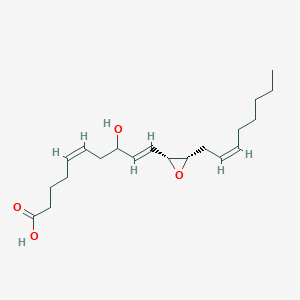
|
11,12-epoxy-8-hydroxyeicosa-5,9,14-trienoic acid |
11,12-epoxy-8-hydroxyeicosa-5,9,14-trienoic acid is a lipid of Fatty Acyls (FA) class. |
98 |
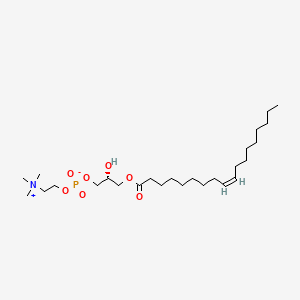
|
1-Oleoyl-sn-glycero-3-phosphocholine |
1-Oleoyl-sn-glycero-3-phosphocholine is a lipid of Glycerophospholipids (GP) class. |
11 |
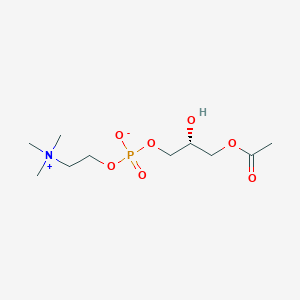
|
Lysophosphatidylcholine |
Lysophosphatidylcholine is a lipid of Glycerophospholipids (GP) class. Lysophosphatidylcholine is associated with abnormalities such as Ischemia, Obesity, Diabetes Mellitus, Non-Insulin-Dependent, Fatty Liver and Atherosclerosis. The involved functions are known as Inflammation, antagonists, Signal Transduction, Signal Pathways and Saturated. Lysophosphatidylcholine often locates in Body tissue, Head, integral to membrane, Membrane and Extracellular. The associated genes with Lysophosphatidylcholine are RHOA gene, Homologous Gene, GPR4 gene, GPR68 gene and TRPV2 gene. The related lipids are Nonesterified Fatty Acids, lysophosphatidylethanolamine, Lysophosphatidylcholines, Phosphatidylserines and 25-hydroxycholesterol. The related experimental models are Knock-out and Disease model. |
4395 |
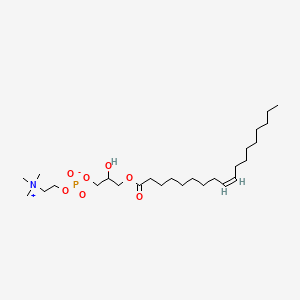
|
PC(18:1(9Z)/0:0)[rac] |
PC(18:1(9Z)/0:0)[rac] is a lipid of Glycerophospholipids (GP) class. |
14 |

|
nystatin |
nystatin is a lipid of Polyketides (PK) class. Nystatin is associated with abnormalities such as Virus Diseases, Infection, Candidiasis, Leukopenia and Mycoses. The involved functions are known as Membrane Potentials, Uptake, Flow or discharge, Cell membrane potential and adenine transport. Nystatin often locates in Cell Wall, Plasma membrane, Extracellular, Membrane and Virion. The associated genes with nystatin are Genome, Integral Membrane Proteins, Amino Acids, Basic, P4HTM gene and Homologous Gene. The related lipids are Sterols, Liposomes, Membrane Lipids, Sphingolipids and 1,2-oleoylphosphatidylcholine. The related experimental models are Knock-out and Xenograft Model. |
4890 |

|
CYTOCHALASIN B |
CYTOCHALASIN B is a lipid of Polyketides (PK) class. Cytochalasin b is associated with abnormalities such as Renal tubular disorder and Chagas Disease. The involved functions are known as Membrane Protein Traffic, inhibitors, Metabolic Inhibition, Biochemical Pathway and Increased Sensitivy. Cytochalasin b often locates in Cytoplasmic matrix, Plasma membrane, Microtubules, Extracellular and Protoplasm. The associated genes with CYTOCHALASIN B are SLC2A2 gene, PFDN5 gene, SLC2A1 gene, OMG gene and SPEN gene. The related lipids are Steroids, Lipopolysaccharides and Liposomes. The related experimental models are Xenograft Model. |
9648 |

|
rotenone |
rotenone is a lipid of Polyketides (PK) class. Rotenone is associated with abnormalities such as Parkinson Disease, MYOPATHY, DISTAL, WITH ANTERIOR TIBIAL ONSET, Neurodegenerative Disorders, Septicemia and Respiratory Failure. The involved functions are known as Phosphorylation, Process, Cell Death, proteasome activity and Apoptosis. Rotenone often locates in Protoplasm, Presynaptic Terminals, Neurites, NADH dehydrogenase complex and Mitochondria. The associated genes with rotenone are DNAJB9 gene, EIF2S3 gene, Candidate Disease Gene, G-substrate and ERN1 gene. The related lipids are Lipopolysaccharides, Membrane Lipids, Phosphatidylserines, Fatty Acids and Cardiolipins. The related experimental models are Knock-out, Mouse Model, Disease model and Rodent Model. |
7079 |

|
quercetin |
quercetin is a lipid of Polyketides (PK) class. Quercetin is associated with abnormalities such as Coronary heart disease, Myocardial Infarction, Cirrhosis, Coronary Arteriosclerosis and Vascular ring. The involved functions are known as Vasodilation, physiological aspects, Fermentation, Process and Ingredient. Quercetin often locates in Arterial system, Endothelium, Skin, Endothelium, Vascular and Tissue specimen. The associated genes with quercetin are P4HTM gene, SULT gene, UGT1A1 gene, ARHGAP26 gene and PLXNB1 gene. The related lipids are blood lipid, Promega, Steroids, Phosphatidylserines and Fatty Acids. The related experimental models are Knock-out, Mouse Model, Xenograft Model, Tissue Model and Cancer Model. |
5377 |
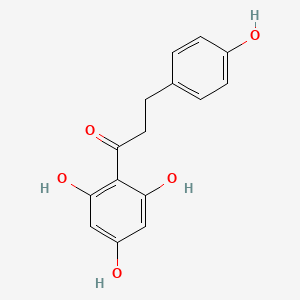
|
phloretin |
phloretin is a lipid of Polyketides (PK) class. Phloretin is associated with abnormalities such as Atherosclerosis, Diabetes Mellitus, Non-Insulin-Dependent, Alkalemia, Renal tubular disorder and pathologic fistula. The involved functions are known as Anabolism, glycosyltransferase activity, Biosynthetic Pathways, Localized desquamation and Biological Processes. Phloretin often locates in soluble, BL21, Cytoplasmic, Extracellular and Cytoplasm. The associated genes with phloretin are Homologous Gene, CD36 gene, Candidate Disease Gene, SLC33A1 gene and PAK1IP1 gene. The related lipids are Liposomes, Palmitates, Fatty Acids, Sterols and 6-ketocholestanol. The related experimental models are Knock-out. |
2367 |









